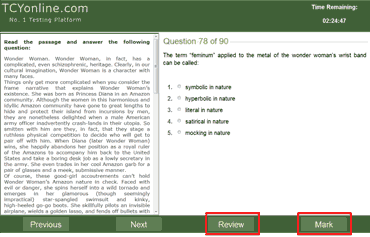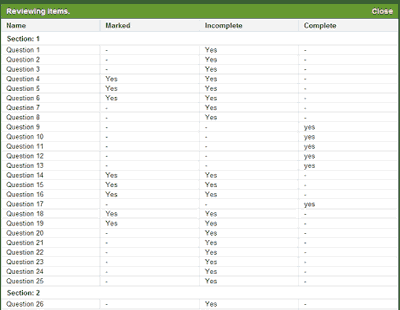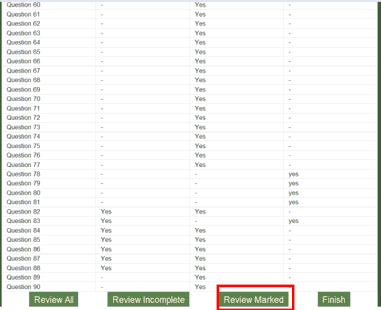 Now that most of the surprises related to the computer version of CAT (www.tcyonline.com/cat2009/mockcats.php) have been uncovered in the last two months (except for the ones you have yet to face between November 28 and December 7 at your test centres), it's time to take a closer look at the new Official Test Interface. Moreover, the need to utilise the tabs and buttons most effectively can not be over-emphasised at this point.
Now that most of the surprises related to the computer version of CAT (www.tcyonline.com/cat2009/mockcats.php) have been uncovered in the last two months (except for the ones you have yet to face between November 28 and December 7 at your test centres), it's time to take a closer look at the new Official Test Interface. Moreover, the need to utilise the tabs and buttons most effectively can not be over-emphasised at this point.
Here, computer-based examination experts from TCYonline help you familiarise yourself with the test interface so as to make the most out of each feature that it offers. So here's how to master the art of managing time effectively in CAT 2009.
Know thy battlefield
The first step in the preparation process is to know the features of the test interface introduced by Prometric. The ollowing is a snapshot of the testing interface that TCYonline has prepared which precisely simulates the official CAT interface:

The above snapshot shows us the four tabs. Additionally, it has also been confirmed that questions will appear one at a time as shown above. Of the four tabs, the most important are 'Review' and "Mark'. 'Review', because it is the only way one can jump through the sections and multiple questions and 'Mark', because, if utilised properly, it can be the perfect time-saver.
How to attempt CAT
These tips might be the same as those advised since CAT 1999 (for a paper-based test), nevertheless, the difference lies in utilising the 'Review' and 'Mark' tabs to your advantage. Here is what you need to do before starting to solve any question:
Now that you know what to expect, TCYonline recommends the following three stages to help you escape the stress:
Round 1: Raise your confidence
Focus on attempting only the questions that are on topics you are strong in. A question that is expected to take less than alarm time for you qualifies to be taken up in R-1.
Now, you should also work smart. While attempting the selected questions in R-1, you must automatically prepare a list of questions that deserve to be attempted in R-2.
How?
Just put the 'Mark' tab to its best use. That is keep on marking the questions that are expected to take a little more than the alarm time, so that when you start R-2 you do not lose focus. Also, ensure that you do not mark more than 22 to 25 questions as you will not have enough time in R-2 to answer more than these many questions.
We urge you to start with the section that is your strong area, no matter if it is Section 3 of the test. You may jump sections using the 'Review' screen. This is how the Review screen will appear:

Remember that in DI, most of the questions appear in sets of three or four. It is recommended that one set of three-four questions should be attempted in this round. Moreover, graph / table / chart-based questions should be preferred over logical games in R-1.
In Verbal, try more questions based on grammar and vocab. You should also try a few RC questions based on some specific stanza (and not the complete passage). Avoid doing inference-based RC questions, para-jumbles and FIJ in the R-1. Do para-jumbles only if the jumbled paras are very small.
Round 2: Reaching the threshold
The main target of R-2 is to clear cut-offs and ensure high accuracy. The best way to do this is to go to the 'Review' screen and click on 'Review marked' written at the bottom. Here, since you have planned and already marked the R-2 specific questions in the R-1 itself, you should be quite comfortable. Here's how your 'Review marked' screen will look:

Questions of R-2 are the ones that may require a little over alarm time and need a few more calculations than those in R-1. You must try attempting two RCs in this round. The first aim is to have a balanced attempt in R-2, for achieving which you must start working on questions from your strength areas. Remember not to get carried away with only one section in R-2 and ignoring the other two. You must do that ONLY AFTER you are certain that you have managed cut-offs in all the three sections.
Round 3: Optimising the score
We say 'optimising' and not 'maximising' since a difference in attitude can make or mar your percentile in CAT. Keep your cool and be very choosy in selecting the right questions to spend your time on.
But how would you determine which questions to do in R-3? Should you choose to 'Review all' or to 'Review marked'?
Actually, in this round, the 'Review' screen decides your navigation. You may click on the 'Review incomplete' tab or select one untouched question at a time and remember to get back to the 'Review' screen after attempting each question. However, first you have to see whether all the marked questions have been attempted in R-2 or not. If there are still a few remaining, prefer those.
Then, check the number of questions attempted in each section and see if one section has not been attempted much. If you find that you had a balanced attempt, you may now attempt the section that is your strength area to optimise your score.
The time limit for the three rounds may vary from person to person but lies almost in the given range. We recommend you to try this method in your mocks to ensure perfection.
TCYonline offers the largest benchmarking pool and the most comprehensive online CAT prep course (www.TCYonline.com/cat2009/preparation_cat.php) with access to TCY Analytics, Test Generator, Audio Visual Lectures, All India e-CATs (http://www.tcyonline.com/cat2009/mockcats.php) on the real CAT pattern and e-Non-CAT Series for SNAP, IIFT, NMAT, FMS, JMET & XAT.